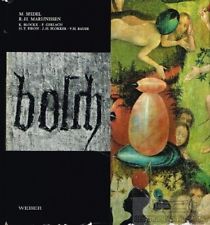
Piron 1972
“Over de psychoanalytische interpretatie van Hiëronymus Bosch” (H.T. Piron) 1972
[in: R.-H. Marijnissen et al., Hiëronymus Bosch, Arcade, Brussels, 1974 (2) (first edition: 1972), pp. 167-185]
[Also mentioned in Gibson 1983: 142 (G47)]
Piron offers a radical but interesting psychoanalytical approach of Bosch. Initially, he pretends to be the cautious, intelligent Bosch expert who keeps his distance from all those contradictory theories. According to Piron the art of Bosch is still highly enigmatic, both in the details and as a whole. Many interpretations of Bosch are strongly subjective, arrogant and self-assured, or they shy away from final conclusions because the time is not yet ripe for it. Piron himself seems to belong to this latter group.
But then he introduces his objective: to look with the help of psychoanalysis for that other thing in the subconscious that generates both Bosch’s fantasies and the diverging interpretations of his art (Panofsky already had positive expectations about psychoanalysis in this respect). Next Piron suggests that Bosch suffered from an Oedipus complex: he did not sign with his father’s name but with a pseudonym, he frequently painted the temptations of St Anthony (his father’s Christian name), he never had children (so he never was a father) and he never painted the important moment of the Annunciation (thanks to the Son’s sacrifice all men would again become children of the Father). His own fatherhood and the confirmation of a natural ànd supernatural fatherhood are both lacking with Bosch.
Referring to the mutilated bodies and the tortured saints Piron further suggests that Bosch had strong sadomasochistic tendencies. But whether this was due to an obsessional neurosis remains but a vague suspicion.
Piron points out the common clue behind all those different interpretations by means of a study of the paradisiacal nude bodies in the central panel of the Garden of Delights, thus limiting this ‘common clue’ to that same panel. According to Piron, when focusing on this central panel the viewer goes through three phases. First he sees lustful activities, then he notices their sweet and innocent nature and finally he is struck by the non-sensual character of the whole panel, to be associated with ‘boredom’. For each of these three moments matching theories can be found in the literature on Bosch: some of them refer to the sin of Luxuria, others point out the positive meaning of the panel (Fraenger i.a.) and yet others suggest that a permanent life in a paradise leads to boredom. In the end, Piron’s approach remains rather fragile and vague here.
The author then concludes that probably Bosch delivered his message in an unconscious way: the absurdity of all human pursuit of lust and holiness. By painting this message, by using an enigmatic imagery and by signing with a pseudonym Bosch was hiding himself somehow: it enabled him to keep the world at a distance.
[explicit]